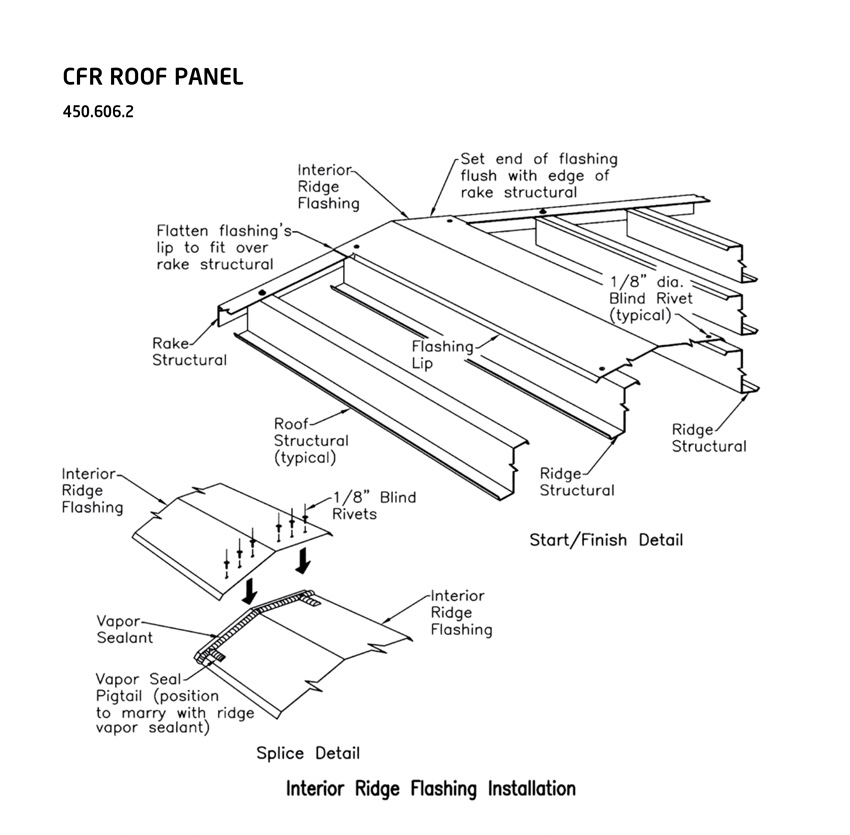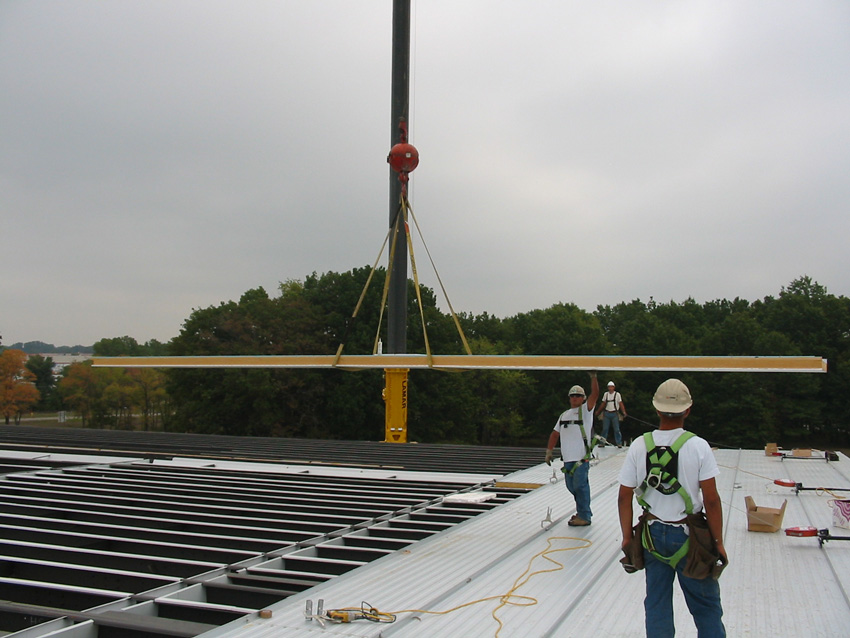Insulated Metal Panels On the Roof
Prepare to Install
“Prior to installation, preinstallation meetings are essential for all trades,” says Wolf, “particularly those involved in the air barrier installation. This enables discussions on material transitions and how to handle hand-offs from one trade to another. Fortunately, IMPs provide a more complete assembly, reducing the number of trades involved, thereby simplifying coordination.”
Even so, it’s important to have an IMP technical representative review the structural framing specification tolerances shop drawings, and attend the structural framing preconstruction conference to ensure the erector understands the tolerances required for successful IMP installation, according to Kazba. “IMPs should not be field modified, so this means the substrate flatness and squareness tolerances must be met.”
“Perform a thorough examination of the erected structure and require modifications to out-of-tolerance work before commencing IMP installation,” he adds.
Another IMP preinstallation requirement is checking the “as-built” conditions and correcting any deficiencies. Building team meetings, including all the trades, should also take place on a regular basis to promote continued discussions about the interfaces between the roof and other assemblies.
Putting this into practice, Gilbane conducted multiple design and preinstall meetings with the designer, A/E and IMP manufacturer for a soon-to-be-completed project at the University of Iowa Children’s Hospital in Iowa City, where an IMP system for a canopy and vestibule roof is wrapped around the circumference of the building.
“Another key quality assurance measure is building a mockup of the installation and testing it for water leakage,” says Keleher, “in addition to bringing in a building enclosure consultant to advise on proper detailing for flashing systems.”

Flashing systems must be properly applied to the IMP roofing system to ensure weather-tight protection.
Adding in his own piece of advice, Halle suggests both utilizing the IMP manufacturer’s quality assurance and quality control list in addition to drawing up one’s own QAQC punch list.
For the actual IMP installation, while there are a number of steps to follow, bear in mind that the product is installed as a single element, as opposed to the multiple components and installation steps required by other insulated roof systems.
While issues such as correct panel alignment and accurately applying the clips to connect the panels are important, achieving proper air and water infiltration is also essential. Here, MCA’s guide states that a proper seal system is imperative. The most common strategy is a liner side seal network, which involves field applying non-skinning butyl sealant on the structural steel at the panel ends and connecting them to either shop- or field-applied sealant located in the panel side joint.
This will enable each panel to have a complete perimeter of butyl sealant on the liner or warm side, effectively creating a great vapor barrier. At transition areas, including corners or wall-to-soffit edges, proper liner trim is needed to maintain the liner seal continuity.
“For weather tightness, most insulated metal roof panels require a concealed bead of sealant on the exterior of the panel side joint,” says MCA’s guide. “Continuity of panel caulking is critical. All joints and overlaps must be completely caulked to prevent water and air infiltration. Caulking of endlap panel joints is especially key where the lap occurs in the ‘low’ flutes of the panels.”
For the IMP system to work properly, the panels must be precisely aligned. In particular, for the system’s liner seal technology to be effective, proper girt steel alignment must be employed to assure the system’s weather integrity.
Designers and contractors should also be aware that compared to concrete or masonry cladding, metal panel systems have higher coefficients of expansion for thermal movement. This means that expected movement amongst the panels must be calculated, and joints between panels should be wide enough to accommodate thermal expansion and differential movements between panels. Ranging from 1/4-inch wide for small panels to 1-inch wide for larger panels, precisely sizing the joint is based upon panel size, panel location on the building, and tolerance issues.

Prior to installing the IMP roofing panels, thermal expansion and differential movements between panels should be accounted for.
“It all comes down to measurements and compatibility,” confirms Williamson. “There will always be panel movement due to changes in heat and weather conditions so it is vital that you accommodate for this movement and ensure the panels can move slightly without becoming damaged.”
Because panel lengths are often restricted by shipping and handling limitations, it will sometimes be necessary to provide an endlap joint for IMP roof panels. Usually, the liner and foam core will be cut away, which leaves a nominal exterior face extension for a lap over the lower panel. Of course, the length of the extension and endlap depends on the roof slope and panel profile. The endlap joints should then be caulked and fastened according to the roof panel manufacturer’s recommendations.
“Installing liberal and thoroughly continuous sealant beads and spray foam insulation is really important to make each and every seal at an endlap or sidelap a perfect one, which it needs to be,” says Koziol.
Worth the While
Whether it’s IMPs all-in-one building enclosure solution, its fast-tracked erection requiring only one trade for installation, or its multipurpose benefits as a structural deck, insulation, and finish systems, the technology deserves a serious consideration for a number of building types.
“When combined with the inherent benefits of metal facings, insulated metal panels require less maintenance than other exterior systems and meet the most demanding performance requirements,” concludes MCA’s guide.

|
Metl-Span is a dynamic industry innovator dedicated to manufacturing and marketing the highest-quality insulated building panel products. Since our origination in 1968, we have been pioneers in research, design, production, and sales of state-of-the-art insulated metal panels and building materials serving the commercial, industrial, and cold storage industries. We are a recognized leader in the advancement of insulated metal panel technology. With our history of visionary product design—and by consistently setting the highest standards in technological advances—architects, designers, and builders trust Metl-Span panel products to perform reliably, be aesthetically pleasing, and come with a proven sustainability track record. Structural integrity, tireless testing, and a determination to exceed expectations are primary to Metl-Span’s focus. At Metl-Span, form meets function in the most reliable, cost- and energy-efficient manner possible. www.metlspan.com |









